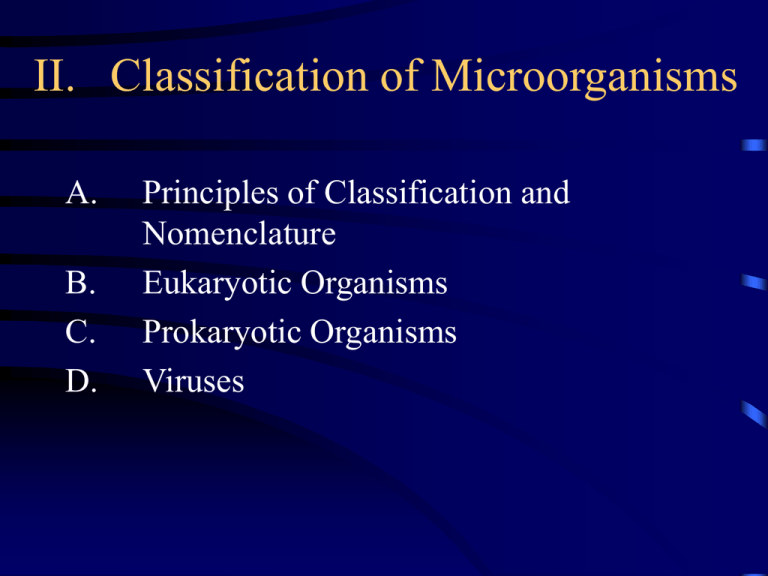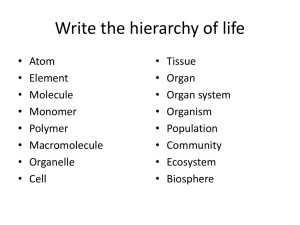II. Classification of Microorganisms
advertisement

II. Classification of Microorganisms A. B. C. D. Principles of Classification and Nomenclature Eukaryotic Organisms Prokaryotic Organisms Viruses II. A. Principles of Classification and Nomenclature • Taxonomy – Kingdom – Phylum (pl: Phyla) – Class – Order – Family – Genus (pl: Genera) – Species (pl: Species) II. A. Principles of Classification and Nomenclature • Phylogenetic vs. Phenetic Classification Systems – Phylogenetic Classification System: Groups reflect genetic similarity and evolutionary relatedness – Phenetic Classification System: Groups do not necessarily reflect genetic similarity or evolutionary relatedness. Instead, groups are based on convenient or observable characteristics. II. A. Principles of Classification and Nomenclature • Definition of “species” in microbiology – Type strains: “Known” well-characterized pure cultures; references for the identification of unknowns – American Type Culture Collection (ATCC) II. A. Principles of Classification and Nomenclature • “Species” vs. “Strain” – Species: A specific or defined type of organism, defined by similarity with known species. – Strain: Genetic variation within a species II. A. Principles of Classification and Nomenclature • Nomenclature – Scientific name (Systematic Name) Binomial System of Nomenclature Genus name + species name italicized or underlined genus name is capitalized and may be abbreviated species name is never abbreviated. eg: Bacillus subtilis B. subtilis II. A. Principles of Classification and Nomenclature • Nomenclature (cont.) – Common or descriptive names (trivial names) eg: tubercle bacillus (Mycobacterium tuberculosis) meningococcus (Neiserria meningitidis) Group A streptococcus (Streptococcus pyogenes) II. B. Eukaryotic Organisms • Eukaryotic Cells Have: Complex Internal Membrane System Compartmentalization Membrane-Enclosed Organelles DNA is enclosed in a membrane-bound nucleus Includes: Animal & Plant cells Eukaryotic Microorganisms II. B. Eukaryotic Organisms • Eukaryotic Kingdoms – Kingdom Protista (Protozoa and Algae) – Kingdom Fungi – Kingdom Plantae – Kingdom Animalia II. C. Prokaryotic Organisms • Prokaryotic Cells – Have: No (or few) internal membranes – Many processes that are associated with organelles in eukaryotes (eg. respiration, photosynthesis) are mediated by specialized regions of the plasma membrane in prokaryotes II. C. Prokaryotic Organisms • Prokaryotic Cells (cont.) – There is no membrane-bound nucleus in prokaryotes. Instead the DNA is located within a specialized region of the cytoplasm of the cell called the nucleoid region. There is no nuclear membrane surrounding the nucleoid. – Includes: The Bacteria The terms “prokaryotic cell” and “bacterial cell” often are used interchangeably II. C. Prokaryotic Organisms • Prokaryotic Kingdoms – Kingdom Eubacteria – Kingdom Archaeobacteria II. D. Viruses • Structure of a “Virus Particle” – Noncellular Biological Entity – Contains either DNA or RNA (not both) – Nucleic Acid is surrounded or coated by a protein shell (capsid) – Some viruses possess a membrane-like envelope surrounding the particle II. D. Viruses • Viral Replication – No independent metabolism or replication – Replicate only inside an infected host cell – Do not replicate via a process of cell division – Replicate via a process of: • Attachment and Penetration • Disassembly (uncoating) • Synthesis of Viral Protein and Nucleic Acid • Reassembly of new viral particles • Release of new viral particles





